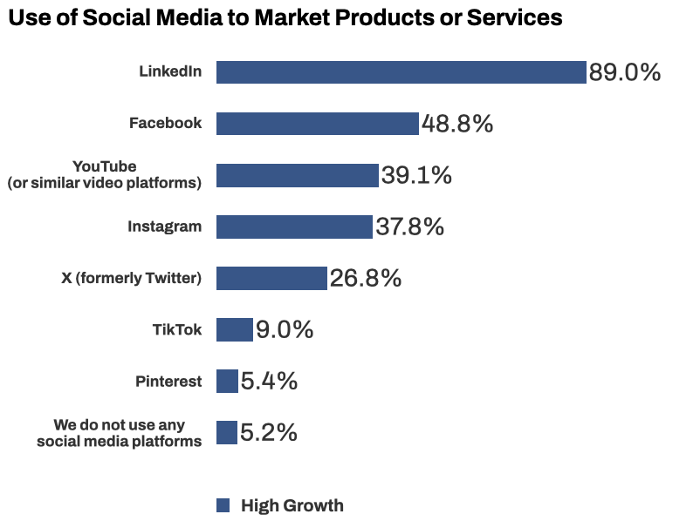We regularly talk about how networking on social media is the number one marketing technique used by the best-performing professional services firms (we call these High Growth firms.) Social media is also a convenient way to build business relationships, share thought leadership content and expand the visibility of your experts and your firm. But that doesn’t mean all social media platforms are equal. There’s one dominant player, and then there are the rest. Here’s the data:

Source: 2024 High Growth Study
As you can see, LinkedIn—used by nine out of ten High Growth firms—commands the field. It’s used 55% more often than the second most popular platform, Facebook. Not only is it the largest social network for professionals, almost everyone you want to become a client, hire or connect with is on it.
If you are going to use just one social media platform, make it LinkedIn. In fact, you would be far better off putting all your social media into LinkedIn than dabbling in several social channels. Granted, Facebook and YouTube are useful for specific tasks (promoting your culture and hosting video, respectively), but they can’t hold a candle to LinkedIn when it comes to versatility and reach.
Profiles Come in Two Flavors
There are two types of LinkedIn profiles: company profiles and personal profiles. Both have their value, but I’m going to focus here on personal profiles. And you should do the same. Why? Because they have the most potential to build visibility, generate engagement and move the needle.
What makes personal profiles more powerful than company pages? Professional services firms are collections of experts. Sure, people hire firms. But they follow and listen to experts. Experts have faces and personalities. Interacting on LinkedIn with actual people feels more natural and productive.
How to Get the Most Out of Your LinkedIn Profile
I don’t have room here to teach you everything about LinkedIn. There are a lot of great resources online for that. But I can provide a few tips to help you build a successful LinkedIn program.
1. Update your profile
You probably already have a personal profile. But chances are, it’s not presenting you in your best or most differentiated light. People will check you out before reaching out, so be sure your personal profile is tidy, up-to-date and complete. Use a professional photo for your profile picture. And the headline is no place to be shy—if it fits your personality, write something provocative, pointed or at least interesting. Think beyond your title. What are you an expert in? Add that to the headline. Mine for example reads as follows:
Managing Partner at Hinge, Brand Strategy and Growth Expert for Professional Services Firms
The goal is to capture a visitor’s attention right off the bat and allow them to see how they can relate. Titles alone don’t do that.
In the About section, summarize your background, accomplishments and responsibilities. Include information about your firm, too. If you have written blog posts or online articles, share them in the Publications section. Don’t forget to address the Skills section so that clients and colleagues can endorse the things you are good at.
2. Make sure you’re connecting with the right people
As you build your network, consider the makeup of your connections. Do you reflexively add anybody who asks to connect with you? If so, you may have a high proportion of people who are more interested in selling to you than learning and buying from you. Instead, you want to connect with clients, prospects, other industry leaders, colleagues and teaming partners.
How do you change the mix? Start by asking current and past clients to join your network. Most will be happy to do so. And as you meet new prospects, make a habit of connecting with them on LinkedIn—and the sooner you do this after your contact the better. When you send your invitation, don’t use the default message. Write your own, instead. Show that you are genuinely interested in them as people. This is not the time to promote your services. Keep it simple and friendly.
3. Share content. Not just yours.
LinkedIn is a fantastic place to share the content that you produce. It can have been published anywhere, not just on the LinkedIn platform. Whenever you create a blog post or online article—or even a video—write a short post introducing the piece, and include a link. Add relevant hashtags if you like.
While it’s important to share your own perspectives, we recommend that you spend 80% of your effort engaging with content posted by others. Write thoughtful comments, share others’ articles, like posts and send happy birthday messages. Be helpful and generous with your expertise.
4. Post something thoughtful at least once a week
You can’t build a following if nobody hears from you. You don’t need to post every day, but consistency is important. What you write about is up to you. Share a positive experience you had with a client. Comment on a breaking news item in a client industry. Post an interesting piece of data and offer your perspective. Or, as I discussed above, share a piece of content.
There’s a lot more I could say about LinkedIn, but if you take these four tips to heart you will be doing more than 95% of your competitors. And that will give you a real leg up in the marketplace. How much time should you spend on these activities? An hour a week should be plenty, and you’ll use much of that time finding and reading other people’s content. Gradually, your LinkedIn connections will grow, and your followers will look forward to your next posts and interactions.
LinkedIn can play a big role in your transition from a professional working in relative obscurity to an expert with far greater exposure and status. And that can have huge implications on your reputation and earning potential!

